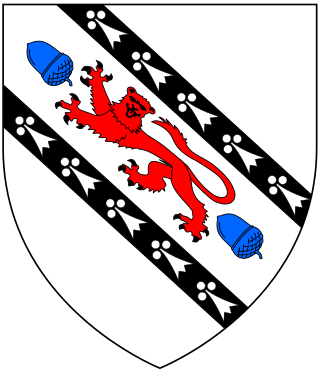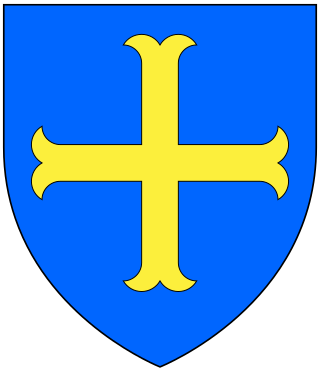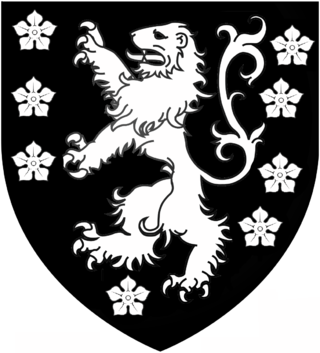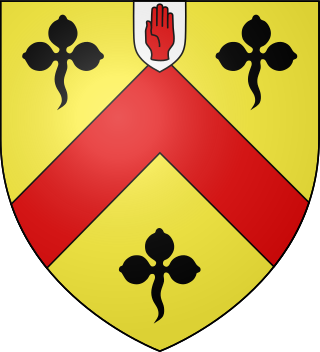
There have been six baronetcies created for persons with the surname Smyth, two in the Baronetage of England, one in the Baronetage of Great Britain, one in the Baronetage of Ireland and two in the Baronetage of the United Kingdom. One creation is extant as of 2010.

The Anderton Baronetcy, of Lostock in the County of Lancaster, was a title in the Baronetage of England. It was created on 8 October 1677 for Francis Anderton of Lostock Hall in the parish of Bolton le Moors, Lancashire. The Andertons of Lostock were descended from the ancient family of Euxton Hall, near Chorley, Lancashire. They acquired Lostock by marriage in the 13th century. They were a devout Roman Catholic family and their estate was lost by sequestration in 1615 due to recusancy but was restored after the English Reformation to Francis Anderton the first Baronet. The third, fourth, fifth and sixth Baronets were brothers. On the death of the third Baronet, his heir, his brother Lawrence, a Benedictine monk succeeded to the Baronetcy but relinquished his claim to the Lostock estate. However his younger brother Francis, a Jacobite, was convicted of High Treason for his part in the Battle of Preston (1715) and the estate was again lost by sequestration. Lawrence returned from France, renounced his Catholicism and successfully reclaimed the estate. Francis was pardoned and on his death succeeded to the Baronetcy but he did not recover the estate which passed to his sister and her husband. The Baronetcy became extinct on the death of Sir Francis in 1760.
John Burke was an Irish genealogist, and the original publisher of Burke's Peerage. He was the father of Sir Bernard Burke, a British officer of arms and genealogist.

There have been two baronetcies created for persons with the surname Head, one in the Baronetage of England and one in the Baronetage of the United Kingdom. One creation is extant as of 2007.

Sir Francis Rodes of Barlborough Hall in the parish of Barlborough, Derbyshire, was an English judge who took part in the trial of Mary, Queen of Scots. He built Barlborough Hall and was one of the founders of Netherthorpe School.
The Kniveton Baronetcy, of Mercaston in the County of Derby, was a title in the Baronetage of England. It was created by King James I on 29 June 1611 for William Kniveton of Mercaston Hall, Muggington, Derbyshire. The family originated in the village of Kniveton,, from where their name derived. Branches of the family later had seats at Bradley and by virtue of the 15th century marriage of Nicholas Kniveton, at Mercaston, near Muggington, Derby

There have been three baronetcies created for descendants of the ancient Norman family of Molyneux who were granted extensive estates in Lancashire after the Norman Conquest.
There have been two baronetcies created for the Pye family. Both are now extinct.
The Sheriff of Nottinghamshire, Derbyshire and the Royal Forests is a position established by the Normans in England.
The Coke baronetcy of Longford, in the County of Derby was created in the Baronetage of England on 30 December 1641 for Edward Coke.

The Hildyard Baronetcy, of Patrington in the County of York, was a title in the Baronetage of England. It was created on 25 June 1660 for Robert Hilyard, of Patrington and Winestead. The ancient Hildyard family is thought to have been of Norman origin. Robert Hildyard served as Gentleman of the Bedchamber to King Charles I of England and was a major-general in the King's army during the English Civil War. He took part in the Battle of Marston Moor. He was raised to a baronetcy by Charles II following the Restoration of the Monarchy. He was succeeded by his grandson Sir Robert Hildyard, 2nd Baronet, a Member of Parliament for Hedon. He was succeeded by his nephew, the third Baronet, who was Member of Parliament for Great Bedwyn. The latter's son, the fourth Baronet, was High Sheriff of Yorkshire in 1783. On his death in 1814 the baronetcy became extinct.
The Bland Baronetcy, of Kippax Park in the County of York, was a title in the Baronetage of England. It was created on 30 August 1642 for Thomas Bland, of Kippax Park, near Leeds, Yorkshire, in honour of his father's service to King Charles I. The third Baronet succeeded his father as an infant, died at the age of five and was succeeded by his brother who was Member of Parliament for Appleby 1681 and for Pontefract 1698–1713. The fifth Baronet represented Lancashire 1713–27 and the sixth Baronet served as member for Ludgershall 1754–5. His brother succeeded in 1755 but died in 1756, at which time the baronetcy became extinct.

Two unrelated baronetcies have been created in the surname of Clifton.
The Vernon family was a wealthy, prolific and widespread English family with 11th-century origins in Vernon, Normandy, France. Their extant titles include Baron Vernon and Vernon baronets of Shotwick Park.
There have been two baronetcies created in the Baronetage of England for members of the Colepeper family of Kent and Sussex. Both are extinct.
Sir John Gell, 2nd Baronet was an English politician who sat in the House of Commons at various times between 1654 and 1689.
There have been three baronetcies created for persons with the surname Humble, two in the Baronetage of England and one in the Baronetage of the United Kingdom. All are extinct.

Philip Eyre Gell (1723–1795) of Hopton Hall near Wirksworth, Derbyshire, was a wealthy lead-mining aristocrat.

The Blount Baronetcy, of Tittenhanger in the County of Hertford, was created in the Baronetage of England on 27 January 1680 for Thomas Pope Blount. In the 16th century Elizabeth Blount, daughter of Sir Walter Blount of Blount Hall, Staffordshire, married Sir Thomas Pope of Tittenhanger, Herefordshire. Her nephew Sir Thomas Pope Blount inherited the estate at Tittenhanger on her death. The first Baronet was the grandson of Sir Thomas and son of the traveller Sir Henry Blount. He represented St Albans and Hertfordshire in the House of Commons. The title became extinct on the death of his grandson, the third Baronet, in 1757.

The Abdy baronetcy, of Albyns, in the County of Essex, was created in the Baronetage of England on 9 June 1660 for Robert Abdy. It became extinct on the death in 1759 of the 4th baronet.











